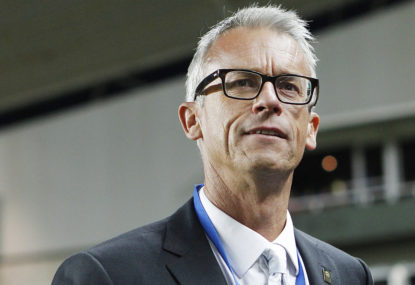As the A-League heads into its ninth season, the ongoing issues surrounding its structure are rearing their heads once again.
This time it’s in the guise of A-League owners forming an owners’ group, with the issue of the length of A-League licenses at the top of the agenda.
Thankfully, unlike the bitter tensions that exploded at the end of the A-League’s seventh season following years of simmering discontent, the current climate is one of healthy creative tension in the spirit of “keeping football current”.
This is absolutely necessary in any organisation, let alone football, in order to prevent stagnation.
An enthusiastic proponent of owner’s interests, Perth Glory’s Tony Sage is quoted in the aforementioned SBS article as saying that “These are cooperative discussions between ourselves and FFA, we are not anti-them, but we do need a resolution. I think we are all on the same page.”
This is a welcome change in tone from some of the bitterness that has risen to the surface throughout the A-League’s nine years.
It is useful to look at some of the comments attributed to Central Coast Mariners chief Mike Charlesworth.
“The clubs are basically being leased out,” he said. “How are you meant to attract serious investors on that basis? Who would want to buy into a deal on those terms?”
Charlesworth then went on to raise the issues that merchant bank UBS will have in finding a buyer for the Western Sydney Wanderers.
Not only is it telling that the buyers being speculated are sporting institutions rather than the traditional ‘rich benefactor’, it is telling that an area often referred to as a ‘heartland’ of the game with a groundswell of support was unable to get a benefactor to back a ‘franchise’ in the area in the first place.
The issues surrounding the sale of the Western Sydney franchise and the importance of preserving the role of fan engagement and fledgeling traditions illuminates the expectations from the football fraternity on how A-League teams should be managed.
As it stands, the FFA have traditionally exercised a high degree of centralised control over the A-League. This was loosened up at the end of season seven when a ‘joint commission’ of sorts was formed.
A cynic may suggest the only reason the FFA relented to prevent Clive Palmer’s alternative governing body getting any oxygen among the football fraternity.
But it needs to be recognised that the A-League has moved well and truly from its start-up phase into a consolidation phase.
Indeed, there is an argument that the A-League actually moved into this phase four years ago, with the FFA failing to adjust accordingly to the detriment of interest in the league and its average attendance.
There were some good reasons to have a heavily centralised ‘franchise’ model for the national league back in 2005. Firstly, as a start-up operation it is more cost effective and easier to streamline many of the processes, such as kit manufacturing, web operations and sponsorship.
The other reasons were the issues raised in the Crawford Report into the old NSL, including that competion being undermined by some of the clubs having a little too much power to the point where the ‘bigger picture’ suffered.
These reasons for heavy centralisation began to become obsolete around season five of the A-League.
There has only been limited success in giving clubs decision-making capacity on core aspects of their operations – namely, they aren’t arbitrarily restricted to wearing white away strips, a small breadth of templates and a single league-wide kit manufacturer.
Questions persist though as to why we all still have to suffer the generic club website templates.
The clubs don’t have the capacity to make decisions such as profiting from being able to stream pre-season matches.
There is also the highly controversial restrictions clubs have had to face when trying to acquire sponsors that don’t conflict with the FFA’s league sponsors.
These issues have prevented clubs from being able to further forge their own unique identity and the meaningfulness of their association with the local fans who support them.
At the very least it would have assisted in arresting the slide of average attendances as the novelty factor of the A-League’s first years inevitably wore off.
As far as the forward-thinking issue of the length of licenses go, it is a delicate issue. There is a balance that will need to be addressed in terms of needing to ensure a proper sense of longevity, along with needing to be able to cut clubs adrift for the greater good of the game.
Not to mention the scope of finding room for adopting the Bundesliga system of mandating partial fan-ownership of A-League ‘franchises’ over the long term.
This would be useful in cementing their long term place in their respective communities.
Plus it acts to nullify the impact of the A-League not having the best players of the code as it shifts the emphasis from ‘supporting the team’ to ‘supporting the club’ as an institution.
At the very least, there is a need for substantial reform as to allow clubs to gain a much greater say over their own affairs.





























































































